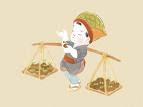::::::::::::::::::::::::::::::::::::::::::::::::::::::::::::::::::::::::::::::::::::::::::::::::::::
Seeds in Spring
***** Location: Japan
***** Season: Spring, Summer see below
***** Category: Humanity
*****************************
Explanation
Spring is a time for planting new crops, flowers and trees.
Here are kigo related to these activities.
. Rice fields and paddies
during all seasons
. Activities in Spring
:::::::::::::::::::::::::::::::::::::::::::::::::::::::::::::::::::::::::::::::::::::::::::::::::::
Kigo for early spring
:::::::::::::::::::::::::::::::::::::::::::::::::::::::::::::::::::::::::::::::::::::::::::::::::::
Kigo for mid-spring
naedoko 苗床 (なえどこ) bed for seedlings
Saatbeet
tanedoko 種床(たねどこ)、byooho 苗圃(びょうほ)
onshoo 温床(おんしょう)warm bed (for seedlings)
fureemu フレーム frame
reishoo 冷床(れいしょう)cold bed(for seedlings)
tane shooji 苗障子(なえしょうじ)sliding doors
(above the bed for seedlings)
The beds for the rice plants are especially important. But other plants are also kept in small warmed beds for early planting.
. . . CLICK here for Photos !
naefuda 苗札 (なえふだ) plate to identify the seedlings
naegi 苗木市 (なえぎいち) market for tree saplings
naegi uri 苗木売(なえぎうり)vendor of tree saplings
tana-i 種井 たない well for the seeds
..... tana ido 種井戸(たないど)
..... tana ike 種池(たないけ)pond for the seeds
..... tane oke 種桶(たねおけ)bucket for the seeds
Many seeds are watered for a while before sown in the fields or in the garden.
tana-ike sarai 種池浚い (たないけさらい)
cleaning the pond for the seeds
tanaike barai 種池ばらい(たないけばらい)、
tana-i barai 種井ばらい(たないばらい)cleaning the well
tana-i gae 種井替(たないがえ)changing (the water) in the well
. Pond, well and related KIGO
tanemono 種物 (たねもの) (all kinds of) seeds
..... monodane 物種(ものだね)
花種(はなたね) seeds of flowers
taneuri, tane uri 種売(たねうり)vendor of seeds
tanebukuro 種袋(たねぶくろ)package with seeds
tanemonoya 種物屋(たねものや)store selling seeds
tane erabi 種選 (たねえらび) selecting seeds
tane yori 種選(たねより)
ueki ichi 植木市 (うえきいち)
market for potted plants and trees
These markets are quite popular in rural areas and often held during the spring festivals of temples and shrines.
. . . CLICK here for Photos !
:::::::::::::::::::::::::::::::::::::::::::::::::::::::::::::::::::::::::::::::::::::::::::::::::::
Kigo for late spring
tane kagashi 種案山子 (たねかがし)
scarecrow in the bed for seedlings
tane hitashi 種浸し (たねひたし) watering the seeds
tane tsuke 種浸け(たねつけ)
tanekashi 種かし(たねかし)、tanefute 種ふて、tane fuseru 種ふせる(たねふせる)
momi tsukeru 籾つける(もみつける)watering unhulled rice grains
tanedoki 種時(たねどき)
tanedawara 種俵(たねだわら)
sujidawara すじ俵(すじだわら)

rice seedlings in a wet bed
My home in Ohaga, Okayama prefecture
. . . CLICK here for Photos of the rice fields in spring !
.................................................................................

tanemaki 種蒔 (たねまき / 種蒔き) sowing seeds
..... tane oroshi 種おろし(たねおろし)
sujimaki すじ蒔(すじまき)
tanemakizakura 種蒔桜(たねまきざくら)
wild cherry blossom tree for sowing
(indicating with its blossoms that it is time to sow and plant. See the chapter about rice planting)
tanemaki okko 種蒔おっこ(たねまきおっこ)
momi maku 籾蒔く(もみまく)sowing unhulled rice
momi orosu 籾おろす(もみおろす)
yudane maku 斎種まく(ゆだねまく)sowing consecrates seeds
(that have been taken to a shrine or temple before and consecrated for a good harvest)
. tanemaki 種蒔 SOWING vegetables and flowers
KIGO LIST
Sowing can be done by hand or with small maschines. Some are sown into plastic sheets with a hole for some seeds at a certain distance between the plants to grow.
:::::::::::::::::::::::::::::::::::::::::::::::::::::::::::::::::::::::::::::::::::::::::::::::::::
:::::::::::::::::::::::::::::::::::::::::::::::::::::::::::::::::::::::::::::::::::::::::::::::::::
Kigo for early summer

naeuri, nae-uri 苗売 (なえうり / 苗売り)
vendor of seedlings (of vegetables and flowers)
naeichi, nae-ichi 苗市(なえいち) market for vegetable seedlings
Many vegetables are sold as small plants for private gardens and fields.
During the Edo period, this was a small income for farmers living close to the cities. Mostly cucumbers, eggplants, taro and sweetpotatoes or flowers like morning glory were sold.
寺の門出て苗売に逢へりけり
tera no mon dete nae-uri e aeri keri
out of the temple gate
I go to meet
the seedling vendor
Kubota Mantaro 久保田万太郎
.................................................................................
. nashi nae 茄子苗 (なすなえ) eggplant seedlings
.SAIJIKI ... HUMANITY
Kigo for Summer
*****************************
Worldwide use
*****************************
Things found on the way
*****************************
HAIKU
お城から見るや種蒔く三十里
o-shiro kara miru ya tanemaku sanjuu ri
from the castle
I see them sowing seeds -
for 30 ri
Masaoka Shiki 正岡子規
one RI is about 4 km.
Here Shiki is taling about the castle of Matsuyama and the surrounding fertile plains.
. Masaoka Shiki 正岡子規
and Matsuyama City 松山
*****************************
Related words
***** Spring (haru) . . . the season
***** Check the WKD LIST of
. HUMANITY and All Spring Kigo
:::::::::::::::::::::::::::::::::::::::::::::::::::::::::::::::::::::::::::::::::::::::::::::::::::






2 comments:
almost spring
a blackbird picks its way
through the snow
almost spring
no seeds yet
for the blackbirds
Ella Wagemakers
Thanks once again!
RW
Post a Comment